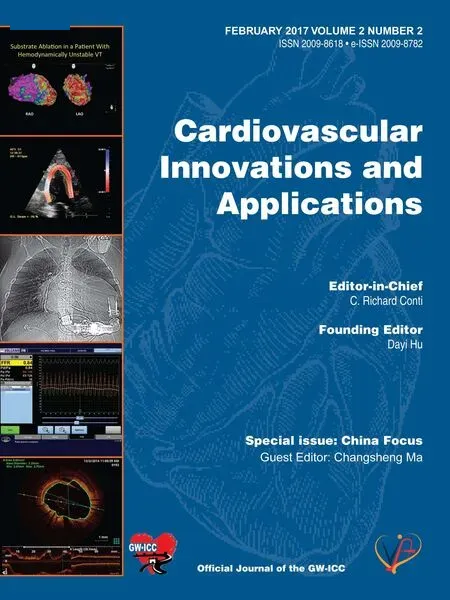Hypertrophic “Obstructive” Cardiomyopathy:Role of Systolic Anterior Motion of the Mitral Valve
C. Richard Conti, MD, MACC
If systolic anterior motion (SAM) of a redundant anterior lea fl et of the mitral valve is combined with systolic thickening of an asymmetric septum,(ASH), a narrow out flow channel of the left ventricle is formed. This narrowed out flow channel is then responsible for the mid systolic pressure difference between the body of the left ventricle and the out fl ow area of the left ventricle. This results in hypertrophic “obstructive” cardiomyopathy(HOCM).
Many years ago, my friend, Dr. William Spencer,then at Baylor College of Medicine, was one of the first cardiologists in the USA to perform Alcohol septal ablation in symptomatic hypertrophic cardiomyopathy patients with systolic pressure differences in the left ventricular out flow area.
Dr. Spencer told me that patients who undergo alcohol septal ablation, almost immediately experience a marked decrease of symptoms. This made me wonder why patients with hypertrophic cardiomyopathy and an out fl ow area pressure difference get symptom relief immediately after alcohol septal ablation?
It seems to me, that since most of these patients have some mitral insufficiency which easily produces symptoms, the only thing that I can think of that would decrease mitral incompetence acutely would be the combination of poor septal thickening and normalizing closure of the mitral valve by
Correspondence: C. Richard Conti,MD, MACC,Department of Medicine, University of Florida, Gainesville,FL 32610, USA, E-mail: richard.conti@medicine.u fl .edu decreasing the amount of systolic anterior motion(SAM) of the mitral valve.
My rationale is that a regional infarction of the septum may result in failure of the ventricular septum to thicken during systole. This in turn may result in widening of the narrowed left ventricular out flow area during systole. When that area is widened, I can envision the Venturi effect decreasing, which then may decrease the systolic anterior motion of the redundant anterior leaflet of the mitral valve. This prevents the anterior leaflet of the mitral valve from hitting the septum during mid systole,preventing or decreasing the pressure difference in the left ventricular out flow area. The anterior leaflet of the mitral valve may then co-apt properly or near properly with the posterior lea fl et. As a result,the amount of mitral insufficiency is decreased,decreasing left atrial pressure, pulmonary venous pressure and pulmonary capillary pressure, and thus reducing symptoms.
Septal myectomy at the time of surgery probably does the same thing, but it takes somewhat longer for the patient to recover since they have had open chest surgery. The surgical procedure (Morrow procedure) focuses on the widening of the left ventricular out flow area due to septal reduction surgery. In contrast, those who undergo alcohol septal ablation of the hypertrophied asymmetric septum (regional myocardial infarction) get a similar reduction of the hypertrophied septum, (at least there is less systolic thickening of the asymmetric septum), but they obtain immediate relief,since they do not have to recover from open chest surgery.
Sorajja et al. [1] recently published an article in which percutaneous plication of the mitral valve(mitral clip) was used to “reduce left ventricular out flow area pressure differences across the outflow area”. The authors focus is on the systolic anterior motion the mitral valve. As I understand it,the anterior mitral leaflet is restrained by the mitral clip, from protruding into the left ventricular area and creating left ventricular out flow area pressure differences. Septal reduction is not involved in this therapy.
Six patients with drug refractory heart failure symptoms underwent this procedure. Five of these patients had a successful result. They found that following mitral clip implantation there was immediate relief of pressure differences in the out fl ow area and decrease in mitral regurgitation in association with the fall in left atrial pressure and rise in cardiac output.
Nothing is mentioned in this article about the time of symptom reduction, but importantly, long term benefits are recorded several years after the procedure. At follow-up, echocardiography demonstrated continued absence of systolic anterior motion of the anterior leaf of the mitral valve and significant reduction in mitral regurgitation.
The authors make the point that this procedure directly targets the mitral valve and retards the mechanism of left ventricular out flow area pressure differences (SAM). In addition, using the mitral clip does not require an iatrogenic septal infarction or ventricular remodeling.
REFERENCE
1. Sorajja P, Pedersen WA, Bae R,Lesser JR, Jay D, Lin D, et al. First experience with percutaneous mitral valve plication as primary therapy for symptomatic obstructive hypertrophic cardiomyopathy. JACC 2016;67:2811–8.
 Cardiovascular Innovations and Applications2017年1期
Cardiovascular Innovations and Applications2017年1期
- Cardiovascular Innovations and Applications的其它文章
- Inherited Cardiomyopathies: Genetics and Clinical Genetic Testing
- The Role of Echocardiography in Hypertrophic Cardiomyopathy
- Rationale and Design of the Randomized Controlled Trial of Intensive Versus Usual ECG Screening for Atrial Fibrillation in Elderly Chinese by an Automated ECG System in Community Health Centers in Shanghai(AF-CATCH)
- Clinical Utility of Amlodipine/Valsartan Fixed-Dose Combination in the Management of Hypertension in Chinese Patients
- The Effect of Home-Based Cardiac Rehabilitation on Functional Capacity,Behavior, and Risk Factors in Patients with Acute Coronary Syndrome in China
- Depression, Anxiety, and Cardiovascular Disease in Chinese: A Review for a Bigger Picture
